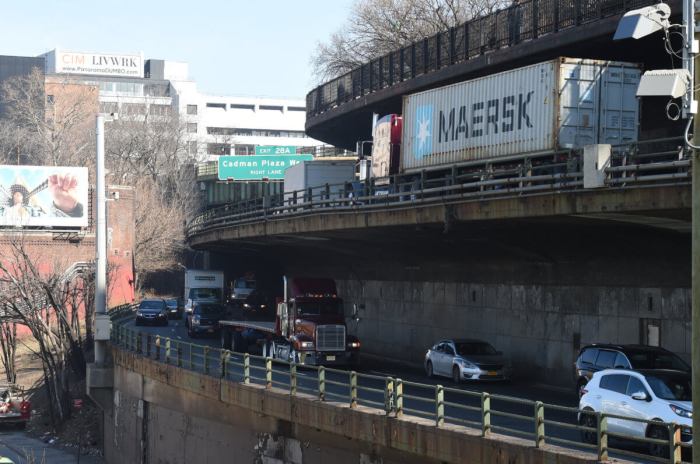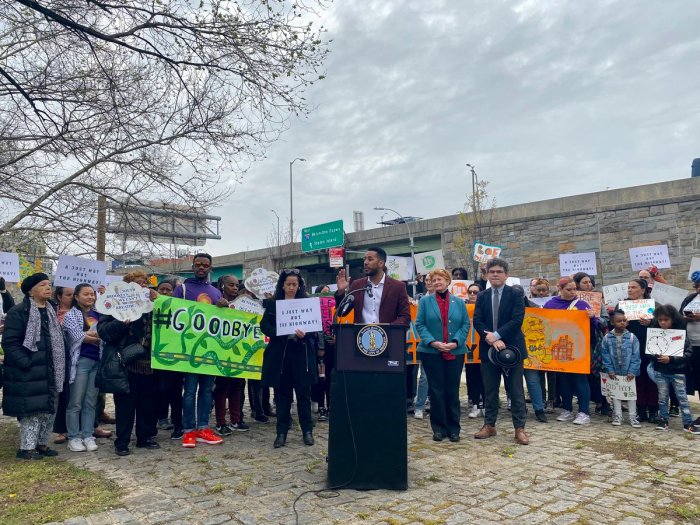This panel got panned!
Mayor Bill de Blasio’s new ‘expert panel’ for the Brooklyn-Queens Expressway lacks watchdogs from elected offices or neighborhood associations, according to the attendees of a Wednesday town hall.
Several audience members at the event, held at Brooklyn Heights’s Plymouth Church, raised the question of why the mayor didn’t select more community reps or watchdogs for his 16-member panel, which is chaired by the head of a building industry advocacy group and includes urban planners, engineers, architects, labor reps, and several academics.
One of the event’s organizers read out an audience question addressing this concern which she said was common among the submitted queries.
“This question came up a lot,” said the co-founder of the activist group to save the Brooklyn Heights Promenade A Better Way, Sabrina Gleizer, before reading out one submission.
“The mayor’s commission has an impressive array of experts but it appears to be thin on community organizers, representatives, and tax payer watchdogs. How can we make sure we are represented,” Gleizer read.
Gleizer and her fellow head of the advocacy organization Hilary Jager met with de Blasio’s office to ask whether they could join the panel, which was unlikely, according to Jager.
“We asked for a seat at the table, I don’t think that’s going to happen,” she said.
But both activists and their partners at the civic group and co-hosts of the event, the Brooklyn Heights Association, agreed that the panel would field the community’s input during the whole process.
“We’re insistent, because we can be really insistent, that we have to have a way to check in with community groups, not just A Better Way, not just the Brooklyn Heights Association, other groups on a regular basis, whether that’s bi-weekly or bi-monthly, we need to have something really set up and we made that clear,” Jager said.
A spokesman for the mayor’s office said that the panel would engage with the community regularly over the next months.
“The panel will be taking input from and engaging substantially with the community through a robust, transparent process,” said Seth Stein. “Throughout that process, the panel will meet with local stakeholders and civic groups to solicit feedback.”
The mayor’s original release left open the possibility for further additions for the panel but Stein said that City Hall didn’t currently have any more panelists to share.
“Additional members are a possibility but we have none to announce at this time,” he said.
The panel will meet this month and examine several current and future proposals for an alternative to the Department of Transportation’s two original plans to either repair the triple-cantilever bit-by-bit or build a six-lane highway on top of the beloved Brooklyn Heights Promenade.
Some time in the summer, they will put forward a short report with their recommendations, according to the mayor’s office.
Civic associations, residents, politicians, and most recently, the international architecture firm Bjarke Ingels Group, have all floated their ideas for the beleaguered roadway.
The Dumbo-based architects, along with Heights local Mark Baker and architect Marc Wouters laid out their ideas to locals at the town hall who applauded the proposals.
In addition to de Blasio’s brain trust, the City Council will hire an independent outside firm to look at the alternatives, Speaker Corey Johnson announced at the event.
“The Council will be hiring an independent firm to evaluate each of the options that are presented so we can understand the pros and cons of every option that’s put on the table,” Johnson said.
A spokesman for Johnson’s office told this paper that they were beginning to hire the firm, but declined to comment on the move’s cost or which company they would tap for the job.
“The Council is beginning the process of hiring an independent firm,” said Jacob Tugendrajch.
Six elected city and state officials attended the meeting and roused the crowd in opposition to the city agency’s original plans, including Johnson, New York City Comptroller Scott Stringer, Borough President Eric Adams, councilman Stephen Levin (D-Brooklyn Heights), Assemblywoman Jo Anne Simon (D-Brooklyn Heights), and state Sen. Brian Kavanagh (D-Brooklyn Heights).
Levin said he didn’t support either of the department’s plans but urged the audience to form a consensus around a plan so that it can have a chance of passing through the city’s Uniform Land Use Review Procedure without hitting any roadblocks, such as litigation or political obstruction along the way.
“We have to get this right and we have to get this right now. I think we’re on track,” he said.
Johnson, along with two other potential future candidates for mayor, Stringer and Adams, railed against the top-down planning of the Robert Moses era, that saw the original construction of the triple-cantilever and envisioned how its reconstruction could change the city’s approach to transport, development, and affordable housing.
“We can’t keep building luxury towers and [pushing] rezonings in the name of affordable housing,” Stringer said. “Because those houses are not affordable to all the neighborhoods in Brooklyn and you know that.”
The fight for a better BQE should be seen as a lesson for other communities in the borough to improve their environment, said Adams, who mentioned a disused elevated subway track that extends from the Myrtle Avenue-Broadway subway stop into Bedford-Stuyvesant as an opportunity for redevelopment, similar to Manhattan’s High Line.
“Everything we’re doing about this fight should be documented and we should go into communities like Brownsville and East New York and teach those young people how to look at their environment as well,” said the Kings County chief executive. “There’s so much more we can do. This should be an exercise of how communities come together and define themselves.”























